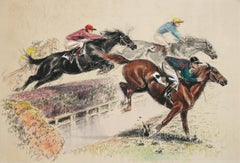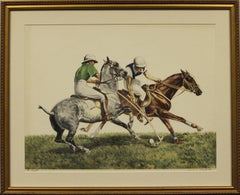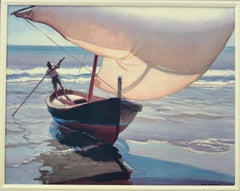Louis Claude Art
to
1
5
Overall Width
to
Overall Height
to
5
1
3
1
5
5
5
4
3
2
2
3
1
1
1
5
8,816
2,808
1,655
1,313
2
4
Artist: Louis Claude
Polo, colour etching, horses, circa 1950
By Louis Claude
Located in Melbourne, Victoria
Titled 'Polo' and signed 'Louis Claude' in pencil below the image. Printed in Paris for the Paris Etching Society, New York.
465mm by 595mm (pla...
Category
1950s Modern Louis Claude Art
Materials
Etching
Saut de la Ravine original watercolor by Louis Claude 1928
By Louis Claude
Located in Paonia, CO
Saut de la Ravine original watercolor by Louis Claude 1928 is a very rare watercolor by Louis Claude created for the publishing house of Sidney Lucas. Mr. Lucas lived in France f...
Category
1920s Other Art Style Louis Claude Art
Materials
Watercolor
$2,275 Sale Price
35% Off
"French Deauville Polo" by Louis Claude`
By Louis Claude
Located in Bristol, CT
Art Sz:17 1/2"H x 23"W
Frame Sz: 23 1/2"H x 28 3/4"W
Classic Louis Claude pencil signed (LR) 'French 'Polo' colour plate
Category
1950s Louis Claude Art
Materials
Lithograph
French Steeplechase Etching
By Louis Claude
Located in Bristol, CT
Art Sz: 20"H x 25"W
Paris Etching Society NY
Category
20th Century Louis Claude Art
Materials
Lithograph
"French Polo Match" 1958 by Louis Claude
By Louis Claude
Located in Bristol, CT
Colour c1958 'Polo' engraving by Louis Claude pencil signed (LR)
Print Sz: 18 1/2"H x 23 1/4"W
Frame Sz: 28"H x 32"W
w/ French matte
Category
1950s Louis Claude Art
Materials
Lithograph
Related Items
Offrandes, Lithograph, Limited Edition Numbered and Signed by the Artist
Located in Palm Desert, CA
Algerian painter Hocine Ziani was born in Algeria, lives and works in France. He is an autodidactartist. Professional painter since 1978-1993 in Algeria, 1994-2009 in France. Foundin...
Category
2010s Other Art Style Louis Claude Art
Materials
Lithograph
$300
H 29.93 in W 22.05 in D 0.04 in
Fishing boat, Spain
By Arthur Rider
Located in Cliffside Park, NJ
Arthur Grover Rider (American 1885-1975)
Offset Litho on board of fisherman in Spain.
Professionally framed and matted in gilt frame.
Born in Chicago, IL on March 21, 1886. Rider ...
Category
20th Century Louis Claude Art
Materials
Lithograph, Offset
Swimmers
By Katherine Bernhardt
Located in London, GB
Edition of 175. 6 Colour lithograph on Somerset Velvet White 300gsm. Signed, titled and dated by the artist.
Category
2010s Louis Claude Art
Materials
Lithograph
Margate Batman
By Joyce Pensato
Located in London, GB
2 colour lithograph on Somerset Tub Sized Satin White 410gsm. Signed and dated by the artist, archival label on verso.
Category
2010s Pop Art Louis Claude Art
Materials
Lithograph
The Steeple Chase figurative
By Benton Clark
Located in Soquel, CA
A vintage, dramatic scene of the rigorous sport of steeplechasing by artist Benton Henderson Clark (American, 1895-1964). Signed and dated lower right "Benton Clark 1945." Presented ...
Category
1940s Abstract Impressionist Louis Claude Art
Materials
Paper, Gouache
Vendredi
By Auguste Herbin
Located in Miami, FL
Vendredi - Plate 10 from the 12 plate Portfolio, 1959
Published by Denise Rene, Paris
Lithograph in colors on heavy paper
20 x 26 inches
Signed, dated and numbered in ink, edition 20...
Category
1950s Abstract Geometric Louis Claude Art
Materials
Lithograph
'L'Escargot' Modern Art Colour Lithograph on Wove Paper
By Henri Matisse
Located in Toronto, ON
Signed on the plate by Matisse.
From the portfolio ‘Dernières Oeuvres de Matisse 1950-1954’, known as Verve Vol. IX No. 35 & 36. Printed by Mourlot in Paris.
Henri Matisse oversaw ...
Category
1950s Fauvist Louis Claude Art
Materials
Lithograph
$2,400 Sale Price
20% Off
H 22.5 in W 17.75 in
Nue
By Auguste Herbin
Located in Miami, FL
Nue - From the 12 plate Portfolio, 1959
Published by Denise Rene, Paris
Lithograph in colors on heavy paper
20 x 26 inches
Numbered in pencil, edition of 64/150
AUGUSTE HERBIN (188...
Category
1950s Abstract Geometric Louis Claude Art
Materials
Lithograph
Bomber and Buckeroos by Till Goodan, Westward Ho Company
Located in Phoenix, AZ
Bomber And Buckeroos ca. 1939
Till Goodan
Offset Lithograph
PRINTS ARE IN GOOD CONDITION. PRINTS MAY HAVE SMALL FLAW ALONG EDGE OF PAPER, DOES NOT EFFECT THE PRINT IMAGE
All the prints are 26 x 31 inches, Mustang Peeler, Bombers and Buckaroos, The stranger, Guardians of the Range and Range Baby.
Note that “The Mustang Runner” is 3 inches shorter in height, 23 x 31 inches
The print by Till Goodan was originally a painting and reproduced by the Westward Ho company as a set. Westward Ho produced the most sought after Western dinnerware ever made. The most popular pattern was the Rodeo pattern by Till Goodan. He Illustrated and branded many accessories sold by the Westward Ho Company.
Tillman Parker Goodan 1896-1958
To the casual observer his paintings are exciting and colorful. To the scholars of the Western Era they are benchmarks of authenticity. Such is the style of Till Goodan. He was born Tillman Parker Goodan in Eaton, Colorado on March 27, 1896. His father was a true western pioneer, mayor of Eaton, publisher of its first newspaper, and County Commissioner for several years.
After moving to California in 1905 and settling on a little farm that bordered the Michel Cattle Ranch, Till spent much of his boyhood with the Michel sons working on their ranch. There he developed his expertise as a calf roper and the skills of a working cowboy.
As a young man Till pursued endeavors that would initially callous his emerging artistic hands. He worked for the famous Miller and Lux Ranch in California. He packed mules and ran pack trains into the Sierra Mountains. He broke horses and competed in local rodeos riding saddle broncs and roping calves. And during the quiet hours he would draw pictures of ranch life and the action of the rodeo. People began commenting on his talents as an artist.
In 1917 he left the rodeo circuit and turned his full attention to a career in art. He studied with Roger Sterrett, William Paxton, and Dana Bartlett, all highly respected California artists. Till soon became a free-lance commercial artist doing work for Grauman’s Chinese and Lowe’s Theaters, Helms Bakery and Security Bank. He later assumed a position as Art Director for the Richfield Oil Company. However, his first love was still the art of the old west, horses, cowboys, and ranching. So, he left Richfield and gave his full attention to the field of fine arts.
He did oil painting, water colors and lithographs. He drew the Gene Autry Comic Books. He illustrated and hand lettered a large collection of stories about famous bucking horses, ranches, horsemen of the world, and western gear. In association with W.C. Wentz, he started producing a complete line of western gift wares, ceramics, bronzes, leather, paper, and fabric.
By the 1930′s he was beginning to receive recognition for his western art and by the early 1940s, he and his daughter, Betty, were illustrating comic books for his longtime friend, Gene Autry. Betty was also a world champion cowgirl.
Till Goodan designs appeared in virtually every medium. But, the most famous was the four lines of dinnerware produced by Wallace China...
Category
1930s American Impressionist Louis Claude Art
Materials
Lithograph
'Lierre' and 'Lierre en Fleur' Modern Art Colour Lithography Duo
By Henri Matisse
Located in Toronto, ON
A Duet of two lithographs by Herni Matisse, both of the same motif - climbing ivy. 'Lierre en Fleur' is Signed on the plate by Matisse. Each piece is 14"x...
Category
1950s Fauvist Louis Claude Art
Materials
Lithograph
$3,975 Sale Price
25% Off
H 22.5 in W 30 in
Boomerang
By Alexander Calder
Located in Miami, FL
Boomerang, 1974
Lithograph in colors on Arches paper
Published by Transworld Art, New York, printed by Mourlot, Paris
29.5 x 43.3 inches
Signed in the plate
***ITEM WILL SHIP UNFRAM...
Category
1970s Louis Claude Art
Materials
Lithograph
"Earnest Eyes" by Chris Hong, Watercolor Painting of Inquisitive Cat in Green
Located in Denver, CO
Chris Hong's "Earnest Eyes" is an original, handmade watercolor painting that depicts a sitting cat with overtones of green. This piece is framed and ready to hang.
Chris Hong is ...
Category
2010s Contemporary Louis Claude Art
Materials
Paper, Watercolor
Previously Available Items
Polo, colour etching, horses, circa 1950
By Louis Claude
Located in Melbourne, Victoria
Titled 'Polo' and signed 'Louis Claude' in pencil below the image. Printed in Paris for the Paris Etching Society, New York.
465mm by 595mm (pla...
Category
1950s Modern Louis Claude Art
Materials
Etching
Equestrian Jump
By Louis Claude
Located in Lake Worth Beach, FL
Equestrian Jump
Size: 19x24 framed original frame 24x33x1
Paris Etching Society 1923.
Original signed color etching title "Jump" by French artist Louis Claude. Shows two polo riders in a dual for the ball. Published by Paris Etching Society a division of the Phyllis Lucas Gallery.
Category
1920s Realist Louis Claude Art
Materials
Etching
Equestrian Jump
By Louis Claude
Located in Lake Worth Beach, FL
Size: 19x24 framed 26x33x1
Hand-colored etching in the original frame pencil signed.
Original signed color etching by French artist Louis Claude. Published by Paris Etching Society a division of the Phyllis Lucas Gallery.
Category
1920s Louis Claude Art
Materials
Etching
Louis Claude art for sale on 1stDibs.
Find a wide variety of authentic Louis Claude art available for sale on 1stDibs. You can also browse by medium to find art by Louis Claude in lithograph, etching, paint and more. Much of the original work by this artist or collective was created during the 20th century and is mostly associated with the modern style. Not every interior allows for large Louis Claude art, so small editions measuring 25 inches across are available. Customers who are interested in this artist might also find the work of Lucien Philippe Moretti, Georges Rohner, and Jean Gabriel Daragnès . Louis Claude art prices can differ depending upon medium, time period and other attributes. On 1stDibs, the price for these items starts at $650 and tops out at $2,275, while the average work can sell for $750.







